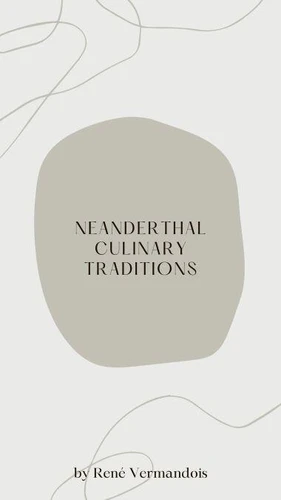Neanderthal Culinary Traditions. AI-Generated Books
Par :Formats :
Disponible dans votre compte client Decitre ou Furet du Nord dès validation de votre commande. Le format ePub protégé est :
- Compatible avec une lecture sur My Vivlio (smartphone, tablette, ordinateur)
- Compatible avec une lecture sur liseuses Vivlio
- Pour les liseuses autres que Vivlio, vous devez utiliser le logiciel Adobe Digital Edition. Non compatible avec la lecture sur les liseuses Kindle, Remarkable et Sony
- Non compatible avec un achat hors France métropolitaine
 , qui est-ce ?
, qui est-ce ?Notre partenaire de plateforme de lecture numérique où vous retrouverez l'ensemble de vos ebooks gratuitement
Pour en savoir plus sur nos ebooks, consultez notre aide en ligne ici
- FormatePub
- ISBN8223466291
- EAN9798223466291
- Date de parution23/10/2023
- Protection num.Adobe DRM
- Infos supplémentairesepub
- ÉditeurDraft2Digital
Résumé
The book discusses the culinary practices of Neanderthals and their impact on modern human diets. Neanderthals were opportunistic eaters who relied on animal meat as their primary food source but also supplemented their diet with wild plants. They were skilled at using fire to cook their food, which improved its taste, digestibility, and safety. Excavations have revealed evidence of ancient hearths lined with herbs and spices, suggesting that Neanderthals possessed a rudimentary knowledge of seasoning.
Studies of dental calculus have shown that they also experimented with plant-based foods, further diversifying their diet. The influence of Neanderthal culinary traditions can still be seen in modern human diets. Traces of Neanderthal genetic influence can be found in the DNA of present-day humans, particularly in populations with Eurasian ancestry. This genetic legacy has shaped our ability to digest certain food groups, such as meat and fat.
Additionally, the culinary techniques and practices passed down from Neanderthals have influenced the development and diversification of global cuisines, including the use of fire, a variety of plant foods, and herbs and spices. There is a profound and multifaceted impact of Neanderthal culinary traditions on modern human diets and emphasizes the enduring legacy of their practices.
Studies of dental calculus have shown that they also experimented with plant-based foods, further diversifying their diet. The influence of Neanderthal culinary traditions can still be seen in modern human diets. Traces of Neanderthal genetic influence can be found in the DNA of present-day humans, particularly in populations with Eurasian ancestry. This genetic legacy has shaped our ability to digest certain food groups, such as meat and fat.
Additionally, the culinary techniques and practices passed down from Neanderthals have influenced the development and diversification of global cuisines, including the use of fire, a variety of plant foods, and herbs and spices. There is a profound and multifaceted impact of Neanderthal culinary traditions on modern human diets and emphasizes the enduring legacy of their practices.
The book discusses the culinary practices of Neanderthals and their impact on modern human diets. Neanderthals were opportunistic eaters who relied on animal meat as their primary food source but also supplemented their diet with wild plants. They were skilled at using fire to cook their food, which improved its taste, digestibility, and safety. Excavations have revealed evidence of ancient hearths lined with herbs and spices, suggesting that Neanderthals possessed a rudimentary knowledge of seasoning.
Studies of dental calculus have shown that they also experimented with plant-based foods, further diversifying their diet. The influence of Neanderthal culinary traditions can still be seen in modern human diets. Traces of Neanderthal genetic influence can be found in the DNA of present-day humans, particularly in populations with Eurasian ancestry. This genetic legacy has shaped our ability to digest certain food groups, such as meat and fat.
Additionally, the culinary techniques and practices passed down from Neanderthals have influenced the development and diversification of global cuisines, including the use of fire, a variety of plant foods, and herbs and spices. There is a profound and multifaceted impact of Neanderthal culinary traditions on modern human diets and emphasizes the enduring legacy of their practices.
Studies of dental calculus have shown that they also experimented with plant-based foods, further diversifying their diet. The influence of Neanderthal culinary traditions can still be seen in modern human diets. Traces of Neanderthal genetic influence can be found in the DNA of present-day humans, particularly in populations with Eurasian ancestry. This genetic legacy has shaped our ability to digest certain food groups, such as meat and fat.
Additionally, the culinary techniques and practices passed down from Neanderthals have influenced the development and diversification of global cuisines, including the use of fire, a variety of plant foods, and herbs and spices. There is a profound and multifaceted impact of Neanderthal culinary traditions on modern human diets and emphasizes the enduring legacy of their practices.






